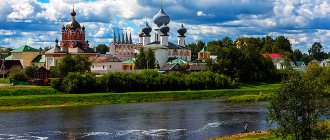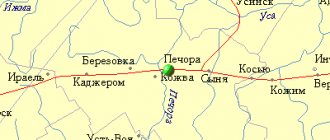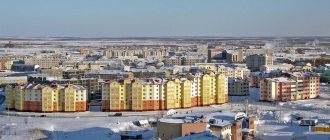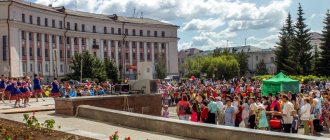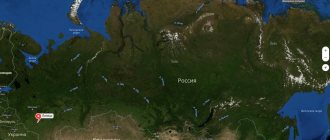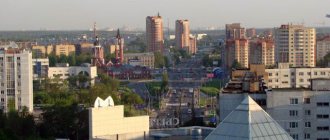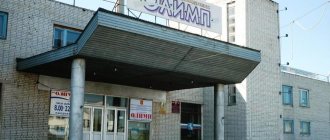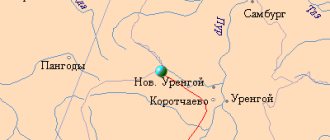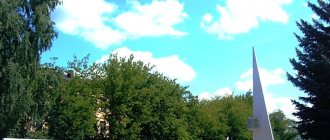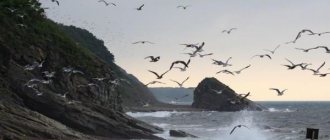Zelenogorsk is a suburb of the northern capital of Russia, which has resort status. Until 1939 it was part of Finland. It was called Terijoki until 1948.
A satellite map of Zelenogorsk shows that the resort is located along the northern side of the Gulf of Finland. Administratively, it is an intra-city municipal formation, part of the Kurortny district of St. Petersburg. It has a length of 13 km along the northern coast of the Neva Bay. Population – 15,000 people.
Zelenogorsk on the map of Russia: geography, nature and climate
Zelenogorsk on the map of Russia is located in the north-west, in the Leningrad region. On the site of the current city there was a swampy area covered with coniferous forests, where a fishing village later appeared. The landscape is an alternation of dunes and hills, rivers, lakes, and ponds. It has a sandy beach 160 m wide.
The temperate and humid climate, transitioning from maritime to continental, is characterized by frequent changes in air masses due to cyclones coming from the Gulf. In winter, moderately mild frosty weather prevails with an average temperature of 5-7 degrees Celsius. Late and prolonged spring, moderately warm summer - dry days alternate equally with rainy ones. In summer, the thermometer reaches 30-35 degrees above zero.
The clean air, saturated with pine and sea aromas, the warm waves of the Gulf of Finland , and sandy beaches attract those who want to improve their health and relax to Zelenogorsk. Thanks to the natural barrier in the form of hills and coniferous trees, the beaches are always protected from the wind.
Population
According to the 2002 All-Russian Population Census, 12,074 people lived in Zelenogorsk, of which 46.2% were men, 53.8% were women.
Population dynamics of Zelenogorsk
| Population, people | ||||||
| 1897 | 1939 | 1959 | 1970 | 1979 | 1989 | 2002 |
| 2 980 | 6 700 | 12 527 | 16 206 | 12 044 | 13 032 | 12 074 |
Routes on the map of Zelenogorsk. Transport infrastructure
There is a railway station in Zelenogorsk (Vokzalnaya st., 2, Zelenogorsk), which can be reached by commuter train from St. Petersburg in an hour or from Vyborg in an hour and a half.
From the center of St. Petersburg you can drive directly to your destination along the Primorskoe Highway , which is a modernized two-lane highway leading to Sestroretsk and St. Petersburg (to the east) and to federal highways A 123, A 125 in the direction of Vyborg and the border with Finland. 15 km to the southeast is the Western High-Speed Diameter , 11 km to the north is the highway leading to Vyborg to the highways A 120, A 122, M 10 , “Scandinavia”.
To the south of the railway is Zelenogorskoye Highway , which leads to Sestroretsk and St. Petersburg past coastal villages.
There are 16 urban and suburban bus routes operating in the village.
What to see in 1 day
Zelenogorsk is a small and compact city.
Therefore, in 1 day you can see many attractions:
- Railway station : at first it was wooden, after 1917 a stone building in the romanticist style was erected in its place. The architect of the project is B. Granholm, who built several railway stations in the Leningrad region. During the war, the building was partially destroyed and reconstructed at the end of 1950.
- National Bank Building: a rare and beautiful building of the city. The house was built in Art Nouveau style and has no sharp corners or straight lines. The architect and time of construction of the house are unknown. The bank building was not damaged during the war years and has retained its original appearance.
- Boots of a nameless summer resident : an object of strange shape and design. Huge bronze shoes stand on the alley of the city park. Compass arrows are placed around them. They symbolize the right of a person to independently choose the path of his life. Everyone tries on the boots and takes memorable photographs.
- Spare railway base : created to accommodate old, used trains, locomotives, steam locomotives. You can see pre-war electric trains, diesel locomotives, and diesel trains. A project has been developed for the restoration and revival of some equipment.
- Mansion of I. Novikov : built in 1914. It belonged to the secretary of the province I. I. Novikov. The building became famous after the pro-Soviet puppet government under the leadership of O. V. Kuusinen worked in it in 1939.
- Villa Ainola : beautiful old cottage. Located next to the Gulf of Finland. Built for his family by N.M. Salko, a famous architect from St. Petersburg. The two-story mansion surprises with its elegant design, variety of finishes, and elegant decor. The villa is interesting as a monument of classical architecture.
- International yacht club on the shores of the Gulf of Finland : opened in 1910 by naval admiral N.I. Skrydlov for sailing racing enthusiasts. Today, yachts from many countries moor at the club's pier. The administration of the sports society provides services to vacationers - trips to the sea, club parties, yacht rental, rental of gazebos for events.
- Pike Lake: for lovers of fishing and outdoor recreation. Located near the city. You can conveniently and quickly get to the lake by train or bus. Shchuchye Lake has a clean beach, a site for tents and a parking lot.
- A small house of A. Akhmatova : stands outside the city, in the village of Komarovo. The house is the property of the Literary Fund. Given to the great poetess in the winter of 1955. Akhmatova lived in it the last years of her life. She was visited by I. Brodsky, F. Ranevskaya, A. Lurie, B. Anrep. The house is constantly being renovated; in the summer, young poets and writers live in it.
To enjoy the sights of Zelenogorsk, its views and monuments, it is recommended to come here in the summer. You can get to the suburbs of St. Petersburg by train, shuttle bus or private car. The city is always full of tourists, pilgrims, and travelers. It is famous for its comfortable stay, original architecture and pristine nature.
Article design: Oleg Lozinsky
Sights of the city Zelenogorsk
Tourists will be interested in visiting local attractions:
- Holy Kazan Church of the Icon of the Mother of God;
- Lutheran Church;
- Chapel of the Nativity;
- museum of vintage cars;
- Yalkala Nature Reserve;
- museum-estate “Penates” by artist I.E. Repin;
- dacha of the poetess A.A. Akhmatova;
- Villa "Ainola";
- Ant Museum at the Children's Library.
Guests of the city are invited to visit the park of culture and recreation, Komsomolsky Square, Bank Square, the Komarovsky Coast and Lindulovo Leafy Grove nature reserves, the petting zoo, and see many sculptural compositions and monuments (“Tree of Happiness”, “Girl Ude”, a monument to the artist George Vitsin).
Museums
The city has interesting and even unusual museums and exhibitions.
Vintage Car Museum
The Museum of Antique Cars is located on the street. Gavannoy, 2. Opened in the fall of 2008 by members of the automobile club. Equipment from the early 20th century is collected here. and later times. The exhibition features 160 cars and motorcycles of different brands, domestic and foreign production. There is a separate exhibition of motor scooters and military vehicles. The exhibitions are constantly updated, changed and expanded.
Visitors can see and photograph the cars of famous people: L. Brezhnev, M. Monroe, Japanese ruler Hirohito, V. Vysotsky, Yu. Gagarin, E. Presley.
Each car is part of the history and development of the automotive industry. The museum is open from 11.00 to 19.00 without breaks and weekends.
Historical and Ethnographic Museum-Reserve Yalkala
The Historical and Ethnographic Museum is located near St. Petersburg, in a dense forest. Yatkala is considered an old museum; its history began back in 1940. At first, the museum’s exhibitions told about the period of the Russian-Finnish war. Then it became a memorial place where V.I. hid during the revolutionary years. Lenin.
After the collapse of the USSR and the rehabilitation of Finnish citizens living on the lands of the Soviet Union, the government created a program to revive the traditions and customs of indigenous local residents. The Yalkala nature reserve appeared. The life of the Finnish settlement is widely represented here, and there is a lot of material about the life of the villagers.
Here you can see:
- national clothes;
- dishes, tools;
- old books, letters, photographs;
- paintings, albums, documents.
A separate hall of the museum is dedicated to the work of the Russian artist and art historian A. N. Benois. Every year, the museum-reserve hosts folk craft fairs, festivals, and holidays. At the end of 2011, a chapel of St. Leonidas was built on the territory of the protected area, where prayers are held for the soldiers who died in the Karelian lands. Museum opening hours: 11.00 – 18.00.
Ant Museum
The museum is located on Lenin Avenue, 12. It is open in the spacious hall of the children's and youth library. The main direction of work of the museum staff is local history. In an interactive form, the children study the history of the city, take online excursions to memorable places in the Leningrad region. They draw a lot, play, and participate in various master classes and quizzes.
Engaged in scientific and research projects. Next to the library building there is a figurine of an intelligent ant with a book. The city government plans to install a dragonfly figurine nearby and complete the composition of the famous fable by I. A. Krylov. The museum is open: from 11.00 to 18.00 – Tuesday-Friday; from 11.00 to 17.00 – Saturday; Day off – Sunday.
Museum of Military Glory
The museum opened in May 1979. Located on the street. Gastello, 19.
More than 2,600 original documents from the Great Patriotic War are collected here:
- military leaflets, maps;
- newspapers “Red Star”, “For Victory”;
- soldiers' diaries;
- notes, notebooks, memoirs;
- weapons, registration cards and belongings of soldiers;
- photographic documents and war newsreels.
Frequent visitors to the museum are schoolchildren, students, and working youth. They are rightfully proud of the exploits and heroism of their great-grandfathers. The museum is available from 11.00 to 18.00 without breaks and weekends.
Museum – estate of I.E. Repina
The museum-estate is located in the village of Repino, a suburb of Zelenogorsk. The museum includes the house of the great painter, a large area of the estate with buildings, a garden and the grave of I. E. Repin. The famous master of painting lived and worked here for a long time. The guides conduct educational walks around the estate and house, talk about the paintings, work, and the last days of the artist’s life.
Unusual things and moments of the excursion:
- round dining table: with rotating center for access to multiple dishes;
- a special palette on the fly: when the master’s right hand failed, he learned to write with his left hand, making an unusual palette for this;
- objects, things: Repin used them for clarity when creating his most famous paintings;
- documentary film: filmed in an estate, shows an old, sick, but not broken, but vigorous and cheerful person;
- access to the artist's studio and visit to his grave.
You are not allowed to take photos or shoot videos in the museum.
The institution is open to the public from 10.00 to 17.00; Closed: Monday, Tuesday.
Don't miss the most popular article in the section: Metro Nizhny Novgorod. Diagram, map, description.
Main streets of Zelenogorsk
Having examined the map of Zelenogorsk with streets, you can see the largest and most important of them:
- Lenin Avenue is 6461 m long. The central street, on which there is a children's library, a Lutheran church, many sculptures and green squares. In the “8 March” park there is the “Tree of Happiness” and the “Ude Girl” fountain, in the “Youth” park there is the “Dandelion” fountain.
- Zelenogorsk highway. It starts from Primorskoye Highway and goes to Red Kursantov Street. Passes through the villages of Solnechnoye, Repino, Komarovo.
- Primorskoye Highway . Its length is 7170 m. It starts in St. Petersburg, runs along the shore of the Gulf of Finland and ends in the village of Smolyachkovo. It is characterized by steep turns, forested areas, and panoramic views. A map of Zelenogorsk with houses shows that in house No. 411 the estate of I.E. is located. Repin "Penates", in house No. 547 - the temple of the Kazan Icon of the Mother of God.
- Komsomolskaya street . Runs from Lenin Avenue to Khvoynaya Street. Intersects with Dalnaya, Razyezzhaya, Sosnovaya Street and Sosnovy Lane.
- Avenue of the Red Commanders (1324 m long). It starts from Primorskoye Highway and ends on Gostinaya Street. Clinic No. 69 is located here.
- Vyborgskaya street . It runs from Torfyanaya Street to Krasnye Kursantov, leading to the railway leading towards Vyborg.
- Mira street. It stretches from Torfyanaya to Shirokaya Street and is part of the Upper Highway. In the northern direction it continues with Vyborgsky Lane, in the southern direction – with Shirokaya Street. Its length is 769 m.
General information
The entire Finnish population left this territory, and it began to be populated by citizens of the USSR.
The settlement received city status in 1946, and in 1948 the city received a new name - Zelenogorsk.
Since 1994, the Zelenogorsk district has been classified as a resort area of St. Petersburg.
Interesting Facts
* Translated from Finnish, Terijoki means “Resin River”.
* In 1908, Terijoki was a large holiday village and enjoyed extraordinary popularity. In the summer there were up to 55 thousand summer residents in the village. Among the Teriok summer residents there were many famous people - officials, artists, musicians, poets, writers and scientists.
* At the beginning of the last century, there were resorts for wealthy people in the village.
* During the first revolution of 1905-1907, there were a large number of safe houses of various revolutionary parties in Terijoki.
* Electricity appeared in the village in 1913
* There is no industry in the city of Zelenogorsk - only retail chains and markets.
* The Zelenogorsk region is famous for its mild climate, picturesque nature, healing sea air and shallow sea with beautiful beaches.
